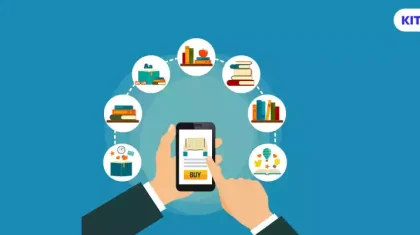
The Power of Visual Learning: Enhancing K12 Textbooks for Students
Summarize this blog with your favorite AI:
With technology revolutionizing education, the use of digital textbooks is on the rise. A prominent aspect of digital textbooks is the incorporation of interactive features.
They help to enhance accessibility, drive engagement, and boost retention. Interactive features also set the stage for visual learning. If you are from the community of K12 textbook publishers, now’s the time to tap into the power of visual learning.
In this article, we reveal how you can implement visual learning elements to enhance K12 textbooks for students.
Let’s get started.
Table of Contents
II. How to Implement Visual Learning in K12 Textbooks
- Understand the Requirement
- Select the Visual Learning Elements
- Use Technology to Incorporate the Visual Learning Elements
- Seek Feedback
- Continue to Improve and Update
III. Types of Visual Learning Elements
IV. Conclusion
What is Visual Learning?
Visual learning refers to a learning mode in which learners respond to information best when it’s presented in a visual form. The use of visual learning elements like images, infographics, videos, etc., helps them to absorb and recall information promptly. Learners prefer such forms of information-sharing over spoken instructions or text.
In the context of K12 education, visual learning can play an essential role. This mode of learning can help students to understand and retain knowledge more effectively.
For K12 textbook publishers, understanding this fact can help them enhance their digital textbooks.
How to Implement Visual Learning in K12 Textbooks
You have to follow a thoughtful approach when implementing visual learning in K12 textbooks. As a publisher, you have to consider how to leverage visual learning elements to help students absorb and retain information.
Here are the steps to guide you in this endeavor:
Understand the Requirement
From the standpoint of K12 textbook publishers, the first thing to do is understand the purpose of this endeavor. Here, the purpose is to enhance K12 textbooks so that learners can derive maximum advantage from them.
The next thing to do is identify the types of visual learning elements that your target audience best responds to. Research a bit to understand the preferences of educators and students as far as visual learning elements are concerned.
You can use online polls and surveys to get a fair idea.
Select the Visual Learning Elements
This is where you start selecting the visual elements that can enhance your K12 textbooks. These can include images, infographics, animated gifs, visual notes, interactive videos, and more.
Remember that the visual element you incorporate in a particular topic should be able to elevate it. For instance, it should create an image in the reader’s mind or add extra information.
You can even use visual learning elements to concise the subject matter and present it in bite-sized form. Ultimately, the purpose is to increase understanding and retention.
Use Technology to Incorporate the Visual Learning Elements
In this step, you have to integrate the visual elements in your K12 textbooks. For this, you will need to leverage technology. You can partner with a digital textbook platform like KITABOO to derive the best results. They can provide you with the technology and expertise needed to enhance your K12 textbooks.
Further, they can ensure that your eBooks remain compatible on multiple devices. This will enable learners to take advantage of the visual learning elements regardless of the device they use for accessibility.
You can even track the consumption and engagement performance of your eBooks. Such metrics will help you to determine the effectiveness of implementing the visual learning elements.
Seek Feedback
Just implementing the visual elements in your eBooks isn’t enough. You will have to seek feedback from both learners and educators. This will help you to determine the usefulness of your visual learning elements in terms of K12 teaching and learning experiences.
The feedback you receive will provide you with opportunities to improve your efforts.
Continue to Improve and Update
Visual learning isn’t a one-size-fits-all approach. It’s not a one-time deal, either. You will have to improve your approach based on the feedback you receive.
Further, you will need to remain updated about the latest trends in this field. This will help you to update your K12 textbooks accordingly.
Types of Visual Learning Elements
To achieve visual learning in your K12 textbooks, you can use various types of visual elements. Some of the popular visual elements include the following:
Illustrations
Illustration refers to the graphical representation of a concept. An illustration can help a learner visualize and understand a concept that’s not easy to understand.
Images
Images serve as the visual representation of a thing, idea, or concept. They enable a learner to imagine whatever is being depicted in the content. Images can easily attract attention and engage the learner.
Interactive Infographic
An infographic is simply information represented in a graphical form. It can comprise an assortment of images, minimal text, and data visualization elements like bar graphs, pie charts, etc.
An infographic can help learners to absorb information about a topic in a concise and easy-to-understand visual format. By making an infographic interactive, you can make it more interesting and memorable for learners.
Animated GIFs
Animated GIFs are moving image files. They can be used to explain various concepts easily and attractively.
You can even use multiple GIFs to explain a single concept or idea. GIFs can break the monotony of learning and help learners understand the topic with a visual incentive.
Interactive Videos
Videos are a highly effective medium for sharing information visually. They can make a great impact on how learners absorb and remember information. Interactive videos can enhance this impact by adding a fun element to it.
Visual Notes
Visual notes refer to drawings comprising text and imagery. They are used to convey the key points of a lesson, lecture, presentation, etc.
Educators and learners can create visual notes digitally in real-time and easily share them. Learners can use visual notes to create mind maps to remember the hierarchy in a concept, complex relationships, etc.
Conclusion
Visual learning serves to engage learners and enable them to understand the subject matter easily. This learning style also helps them to retain information and recall it effectively. By incorporating visual learning elements in your eBooks, you can deliver great learning experiences to K12 students.
Having said that, you need to approach this matter strategically for best results. Teaming up with a digital publishing platform can help you to integrate visual learning into your eBooks easily.
In this regard, you can consider the digital textbook platform KITABOO as a dependable partner. It is an AI-empowered digital publishing platform that has the resources and expertise needed to achieve your objective.
To request a demo of their customized content creation and distribution solutions, contact us here.
Suggested Read:
Discover how a mobile-first training platform can help your organization.
KITABOO is a cloud-based platform to create, deliver & track mobile-first interactive training content.



